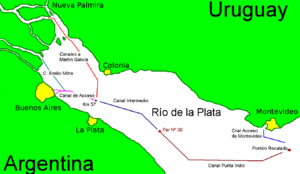1973 Boundary Treaty between Uruguay and Argentina facts for kids
The Treaty of the Río de la Plata is an important agreement between two countries, Uruguay and Argentina. It was signed in Montevideo on November 19, 1973. This treaty helps both countries share and manage the Río de la Plata, which is a very wide river where the Uruguay River and Paraná River meet the Atlantic Ocean.
The main goal of the treaty was to clearly define the border between Argentina and Uruguay in the Río de la Plata. It also set rules for how both countries can use the river and its waters. This agreement helps prevent disagreements and ensures that the river can be used safely by everyone.
Contents
What the Treaty Does
The Treaty of the Río de la Plata does several important things:
- It sets the exact locations for the border points in the Río de la Plata.
- It decides who owns and controls islands like Martín García Island.
- It creates a special group called the Administrative Commission for the Río de la Plata (CARP). This group helps manage the river.
- It sets rules for the ocean areas next to the river.
Sharing the River
The treaty divides the Río de la Plata into different areas, or "zones," to make sure everyone knows the rules.
Exclusive Zones
In some parts of the river, there are "exclusive jurisdiction" zones. This means that only one country, either Uruguay or Argentina, has full control over that area. They can make decisions and enforce their laws without the other country interfering.
Common Zones
Other parts of the river are called "common jurisdiction" zones. In these areas, both Uruguay and Argentina share control. They work together to manage these parts of the river. The special group, CARP, also helps manage these common zones. The treaty made sure that the main shipping lanes, which are like water highways for boats, are in these common zones. This allows ships from both countries, and other countries, to use them freely.
Why the Treaty Was Needed
Sharing a large river like the Río de la Plata can sometimes lead to disagreements. Because the treaty defined the border and how the river should be used, it helped solve some problems. However, even with the treaty, there were still some challenges later on, like the Martín García canal dispute and the Uruguay River pulp mill dispute. These showed that managing shared natural resources can be complex, even with clear rules.
See also
 In Spanish: Tratado del Río de la Plata para niños
In Spanish: Tratado del Río de la Plata para niños


